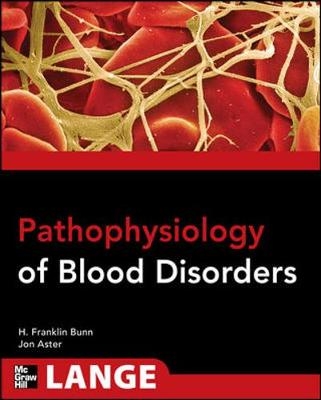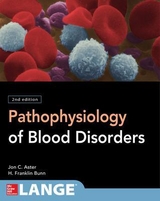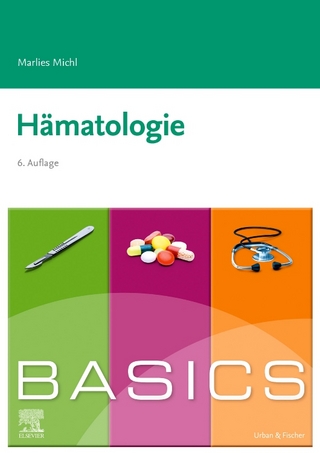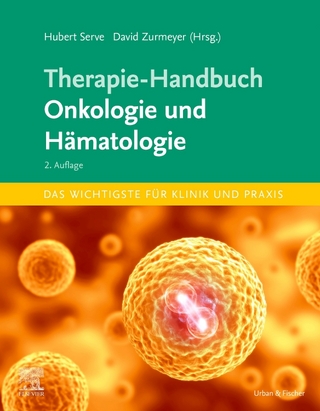
Pathophysiology of Blood Disorders
McGraw-Hill Medical (Verlag)
978-0-07-171378-8 (ISBN)
- Titel erscheint in neuer Auflage
- Artikel merken
This is a concise full-color review of the mechanisms of blood diseases and disorders - based on a Harvard Medical School hematology course 2015 Doody's Core Title! 4 Star Doody's Review! "This is a superb book. Deceptively small, yet packs a wallop. The emphasis on principles instead of practice is welcome...The text is clear, concise, and surprisingly approachable for what could have been a very dense and dry discussion. I could not put this book down and read it entirely in one sitting. When was the last time anyone found a hematology textbook so riveting?" (Doody's Review Service). Hematological Pathophysiology is a well-illustrated, easy-to-absorb introduction to the physiological principles underlying the regulation and function of blood cells and hemostasis, as well as the pathophysiologic mechanisms responsible for the development of blood disorders. Featuring a strong emphasis on key principles, the book covers diagnosis and management primarily within a framework of pathogenesis.
Authored by world-renowned clinician/educators at Harvard Medical School, Hematological Pathophysiology features content and organization based on a hematology course offered to second year students at that school. The book is logically divided into four sections: Anemias and Disorders of the Red Blood Cell, Disorders of Hemostasis and Thrombosis, Disorders of Leukocytes, and Transfusion Medicine. It opens with an important overview of blood and hematopoietic tissues. Features: succinct, to-the-point coverage that reflects current medical education; more than 200 full-color photographs and renderings of disease mechanisms and blood diseases; each chapter includes learning objectives and self-assessment questions; numerous tables and diagrams encapsulate important information; and, incorporates the feedback of 180 Harvard medical students who reviewed the first draft - so you know you're studying the most relevant material possible.
Author Profiles Dr. Bunn and Dr. Aster are outstanding educators in blood diseases at Harvard Medical School. Dr Bunn is a former president of the American Society of Hematology, and has a great reputation among leading experts in hematology.
Table of Contents Chapter 1 - Overview of Blood and Hematopoietic Tissues (Aster and Bunn) Impact of blood in health and disease Red blood cell White blood cells Platelets Blood clotting proteins The bone marrow The spleen The thymus Lymph nodes Chapter 2 - Hematopoiesis and the Bone Marrow (Scadden) Hematopoietic cell diffrerentiation Myeloid lineage Erythroid lineage Megakaryocyte-platelet lineage Lymphoid lineages - B, T, and NK cells The biology of the stem cell Self-renewal Stem cell ontogeny Stem cell trafficking The regulation of blood cell formation The bone marrow niche and cell-cell interactions Cytokines in early hematopoietic differentiation Lineage specific cytokines Cytokine therapy Stem cell therapy Section I - Anemias and Disorders of the Red Blood Cell Chapter 3 - Overview of the Anemias (Bunn) (See full sample chapter) Definition of anemia Adaptations to anemia Alterations in blood flow Changes in oxygen unloading Stimulation of erythropoiesis Signs and symptoms of anemia Pathophysiology of anemia Anemia due to blood loss Anemia due to decreased red cell production Microcytic Macrocytic Normocytic Anemia due to increased red cell destruction Chapter 4 - Anemias due to Bone Marrow Failure or Infiltration (Bunn) Congenital causes of bone marrow failure Acquired aplastic anemia and pure red cell aplasia Myelophthisis Myelodysplasia Leukemias (Myelodysplasia and the leukemias will be covered in detail in Chapters 21 and 22). Chapter 5 - Iron Homeostasis: Deficiency and Overload (Heeney) Normal iron homeostasis Iron binding proteins: transferrin; ferritin The iron cycle Role of hepcidin in iron regulation Iron utilization in erythropoiesis Laboratory evaluation of iron status Serum iron and transferrin saturation Serum ferritin Bone marrow and liver iron stores Serum transferrin receptor Iron deficiency Etiology Clinical features - signs and symptoms Hematological features Treatment Iron overload Primary - inherited mutations in proteins regulating iron homeostasis Secondary - transfusional hemosiderosis Chapter 6 - Megaloblastic Anemias (Heeney) Biochemistry of vitamin B12 and folate Pathophysiology Megaloblastic marrow and peripheral blood morphology Vitamin B12 and folate absorption B12 deficiency Etiology Clinical presentation (signs and symptoms) Laboratory evaluation Treatment Folate deficiency Etiology Clinical presentation (signs and symptoms) Laboratory evaluation Treatment Chapter 7 - Anemias associated with Chronic Disease (Heeney and Bunn) Anemia of chronic inflammation Infection Cancer Connective tissue disorders Pathophysiology - role of hepcidin Lab features Treatment Anemia of renal insufficiency Cause Erythropoietin levels Treatment with erythropoietin and iron Anemia of chronic liver disease Anemia of endocrine hypofunction Chapter 8 - Thalassemia (Nathan) Ontogeny of globin gene expression Organization of alpha and beta globin genes Definition and classification of the thalassemias Mutations responsible for the thalassemias Beta thalassemia Beta+ versus beta0 Beta thal major Cellular pathogenesis Clinical presentation Laboratory evaluation Complications Treatment Red cell transfusion Iron chelation Stem cell transplant Prevention - prenatal diagnosis Beta thal intermedia Beta thal minor Interacting beta thalassemias - Hb S and Hb E Alpha thalassemia Four degrees of gene deletion - correlate with clinical presentation Three alpha gene deletion - Hb H disease Four alpha gene deletion - Hydrops fetalis Prevention - prenatal diagnosis Chapter 9 - Sickle Cell Disease and other Disorders of Hemoglobin Structure (Bunn) Inheritance - beta globin structural mutation: b6 Glu (R) Val The sickling disorders: SS, Sb0Thal, Sb+Thal,SC, AS Molecular pathogenesis Structure of the sickle fiber Kinetics of fiber formation In vivo significance of polymer formation Cellular aspects of in vivo sickling and vaso-occlusion Contribution of Hb F Sickle cell - endothelial cell adhesion Clinical manifestations Constitutional: growth, development and susceptibility to infections Hemolytic anemia Vaso-occlusion Acute pain crises Acute chest syndrome Chronic organ damage Stroke Bone - aseptic necrosis Renal: impaired concentrating ability; impaired glomerular function Pulmonary hypertension Treatment Supportive - analgesia, oxygen, fluid and pH balance Prophylaxis: penicillin and vaccinations Hydroxyurea - induction of Hb F Novel therapeutic strategies Chapter 10 - Other Inherited Hemolytic Anemias (Lux) Disorders of the red cell membrane Molecular anatomy of the red cell membrane Hereditary spherocytosis - mutations in spectrin, band 4.1, band 3 Other inherited membrane disorders Disorders of red cell metabolism Hexose monophosphate shunt and G6PD deficiency Glycolytic pathway - pyruvate kinase deficiency Chapter 11 - Acquired Hemolytic Anemias (Bunn) Acquired membrane disorders Paroxysmal nocturnal hemoglobinuria Spur cell anemia Traumatic hemolytic disorders Thrombotic thrombocytopenic purpura (Covered in detail in Chapter 14) Hemolytic uremic syndrome Disseminated intravascular coagulation (Covered in detail in Chapter 16) Heart valve hemolysis Immune hemolytic anemias Pathophysiologic principles Clinical presentation and course Warm antibody hemolysis Cold antibody hemolysis Lab diagnosis Treatment Chapter 12 - Erythrocytosis (Polycythemia) (Bunn) Pathophysiologic principles: Algorithm for evaluating patients with erythrocytosis Primary erythrocytosis - polycythemia vera (See Chapter 20 f or coverage of molecular pathogenesis, Chapter 22 for clinical presentation and course, diagnosis and treatment) Secondary erythrocytosis Appropriate erythropoietin production High altitude hypoxemia Pulmonary hypoxemia Cardiac hypoxemia (right to left shunt) Mutant hemoglobin with high oxygen affinity Inapproriate erythropoietin production Tumors: renal, hepatic Von Hippel Lindau syndrome Inherited disorders of oxygen sensing HIF pathway Section II - Disorders of Hemostasis and Thrombosis Chapter 13 - Overview of Hemostasis (Furie) Phases of clot formation and dissolution Platelet plug Coagulation Fibrinolysis Molecules that participate in clot formation and clot lysis Platelet activation Adhesion Aggregation Secretion Laboratory evaluation of platelet function Platelet aggregation Bleeding time Blood Coagulation In vitro coagulation cascade Laboratory evaluation Partial thromboplastin time Prothrombin time Thrombin time Fibrinogen Factor assays Factor VIII panel: activity, antigen, ristocetin cofactor, multimer assay D-dimer assay Mixing studies - identification of circulating anticoagulant Anticoagulent/fibrinolytic drugs Warfarin Heparin and heparin mimetics (see Chapter 17) Fibrinolytic agents Chapter 14 - Platelet Disorders (Furie) Acquired Platelet Disorders Thrombocytopenia Decreased production Drugs, toxins Aplasia (Chap 4), myelodysplasia (Chap 22), PNH (Chap 11) Sequestration (hypersplenism) Increased consumption/destruction Immune thrombocytopenia Chronic ITP Acute ITP Drug induced Alloimmune Clinical presentation and course Treatment Thrombotic thrombocytopenic purpura Molecular pathogenesis Diagnostic criteria Clinical presentation and course Therapy Acquired qualitative platelet disorders Drug induced defects in platelet secretion: aspirin, NSAID Uremia Hereditary Platelet Disorders Defective adhesion: Bernard-Soulier Defects of release and of storage pools Defective aggregation: Glanzmann's thrombesthenia Chapter 15 - Inherited Coagulation Disorders (Furie) Factor VIII deficiency (hemophilia A, classic hemophilia) Genetics x-linked mutations responsible for hemophilia A Clinical manifestions of disease Laboratory monitoring Therapy Factor VIII infusion Supportive care Complication of therapy HIV, viral hepatitis Acquired inhibitors (inducible and uninducible) Factor IX deficiency (hemophilia B, Christmas disease) Genetics x-linked mutations responsible for hemophilia B Clinical manifestions of disease Laboratory monitoring Therapy Factor IX concentrate infusion Supportive care Complication of therapy: HIV, viral hepatitis Chapter 16 - Acquired Coagulation Disorders (Furie) Impaired synthesis of coagulation factors Liver disease Drugs Vitamin K deficiency Usual clinical setting Hemorrhagic disease of the newborn Factitious or accidental warfarin ingestion Disseminated intravascular coagulation Etiology Lab diagnosis Treatment Factor X deficiency and amyloid Coagulation factor deficiencies due to specific inhibitor Acquired Factor VIII deficiency Others: V, vWD, etc Lupus anticoagulant/anti-cariolipin (see Chapter 17) Chapter 17 - Thrombotic Disorders (Bauer) Principles of thrombosis and thrombotic disorders Nation-wide and world-wide impact Virchow's triad Inhibitors/regulators of coagulation Anti-thrombin III - effect of heparin Protein S, activated protein C cleavage of Va and VIIIa Tissue factor protein inhibitor Fibrinolysis Risk factors for venous thrombosis Inherited thrombotic disorders Assay measurements Protein C deficiency - warfarin skin necrosis Protein S deficiency Factor V Leiden Prothrombin gene mutation: 20210 G-> A Impact of inherited defects on thrombotic risk Acquired thrombotic disorders Antiphospholipid antibody syndrome (lupus anticoagulant; anti-cardiolipin antibody) Clinical presentation Laboratory diagnosis Treatment Heparin-induced thrombocytopenia Pathogenetic mechanism Clinical presentation Laboratory diagnosis Treatment Section III - Disorders of Leukocytes Chapter 18 - Leukocyte Function and Non-malignant Leukocyte Disorders (Berliner) Distribution of cells within the myeloid/neutrophil compartment Marrow compartment Peripheral compartment Circulating Marginating Determinants of peripheral neutrophil count Production Margination Sequestration Destruction Evaluation of neutrophilia Primary hematologic disorders Congenital - e.g. Down's syndrome, inherited defects in leukocyte adhesion Acquired - e.g. chronic myeloid leukemia Secondary to other disorders Infection Stress Drug induces Chronic inflammation Post-splenectomy Approach to patient with neutrophilia Evaluation of neutropenia Congenital Constitutional, benign Severe congenital neutropenia Neutrophil elastase mutations Kostmann's syndrome Cyclic neutropenia Others Acquired neutropenia Post-infection Drug-induced Vitamin B12, folate deficiency Hypersplenism Immune related Auto-immune Isoimmune - newborns Associated with immune disorders Dignostic evaluation Treatment of neutropenias Depends on severity Wide range of options: supportive, steroids, IgG, G-CSF, stem cell transplant Qualitative abnormalities of neutrophil function Disorders of respiratory burst: chronic granulomatous disease, myeloperoxidase def Abnormalities of leukocyte adhesion and chemotaxis Defects in structure and function of neutrophil granules Non-malignant lymphocyte disorders Lymphocytosis Reactive lymphocytosis; cytomegalovirus, HIV, toxoplasmosis Infectious mononucleosis Lymphopenia: steroid therapy, immunodeficiency syndromes Histiocytic disorders - hemophagocytic lymphohistiocytosis Chapter 19 - Introduction to Hematologic Malignancy (Fleming) Classes of hematologic malignancies Acute leukemias Myelodysplastic syndromes Chronic myeloproloferative disorders Lymphomas Diagnostic criteria Lineage of the malignant cell (cell of origin) Molecular genetic features Clinical features Clinical subtypes of disease Leukemia versus lymphoma Acute versus chronic leukemia Indolent versus aggressive lymphoma Clonality in hematologic malignancies Critical for distinguishing some neoplasms from reactive proliferations Established by a number of techniques X-chromosome inactivation (rarely used clinically) Conventional and molecular cytogenetics Acquired mutations of pathogenetic significance: e.g., JAK2 mutation in PCV B cells: production of monoclonal immunoglobulin protein B cells or T-cells: detection of monoclonal antigen receptor gene rearrangements Chapter 20 - Molecular Mechanisms underlying Hematologic Malignancies (Aster) Chronic myeloproliferative disorders: tumors caused by mutations in tyrosine kinases Pathophysiology: hyperproliferation of hematopoietic progenitors with preserved differentiation Chronic myeloid leukemia: BCR-ABL fusion oncoproteins Polycythemia vera: gain of function JAK2 mutations Chronic eosinophilic leukemia: gain of function FGFR1 or PDGFR mutations Targeted therapies with kinase inhibitors Acute leukemias: tumors caused by complementary mutations in critical transcription factors and tyrosine kinases Pathophysiology: hyperproliferation of blasts and arrested development leading to bone marrow failure Acute promyelocytic leukemia Molecular pathogenesis: PML/RARa fusion proteins + tyrosine kinase mutations Targeted therapy - all-trans retinoic acid BCR-ABL+ acute lymphoblastic leukemia Molecular pathogenesis: Ikaros mutations + BCR-ABL fusion genes Targeted therapy - ABL kinase inhibitors Myelodysplasia Pathophysiology: acquired mutations that lead to apoptosis of hematopoietic progenitors (ineffective hematopoiesis) and disordered (dysplastic) maturation Genetic and cytogenetics Lymphomas: mainly tumors of mature lymphocytes Germinal center B cells - most common origin for human lymphomas Role of genomic instability in germinal center B cell lymphomas Recurrent genetic abnormalities: translocations involving BCL2, BCL6, and C-MYC Other contributors to B cell lymphomagenesis Chronic immune stimulation Chronic immune dysregulation Oncogenic viruses (EBV) T/NK cell lymphomas - rare, usually extranodal, diverse clinicopathologic features EBV-related (subset) ALK tyrosine kinase fusion protein-related (subset) Plasma cell neoplasms and related disorders Pathophysiology Abnormal immunoglobulins Bone resorption Suppression of B cell function Diminished hematopoiesis Genetics: diverse chromosomal translocations involving the IgH locus Chapter 21 - Acute Leukemias (DeAngelo) Impact relative to cancer in general Clinical presentation Laboratory diagnosis Blood and marrow morphology Cell surface markers Karyotype Acute myeloid leukemia Etiology Principles of treatment Induction Post remission consolidation Stem cell transplantation in selected patients Factors influencing outcome Age Karyotype WBC at presentation Rapidity of response to induction therapy Targeted therapy (APML and all-trans retinoic acid) Acute lymphoblastic leukemia Age-dependent incidence Prognostic factors Treatment Induction CNS prophylaxis Consolidation Maintenance Treatment issues Toxicity: myelosuppression, liver, CNS, pancreas Infections Complications of steroid therapy Sites of relapse Chronic lymphocytic leukemia Clinical presentation Staging Prognostic factors Treatment Patients with early stage and/or minimal symptoms require no treatment Chemotherapy Anti-CD20 monoclonal antibody Chapter 22 - The Myeloproliferative Disorders and Myelodysplasia (DeAngelo) Clonal disorders arising from mutated hematopoietic stem cells Chronic myeloid leukemia Molecular pathogenesis: BCR-ABL fusion protein Natural history Laboratory diagnosis Treatment Targeted drug therapy: imatinib and newer tyrosine kinase inhibitors Conventional chemotherapy Stem cell transplantation Polycythemia vera Molecular pathogenesis: JAK2 kinase mutations Clinical presentation and course Laboratory diagnosis Treatment: phlebotomy versus hydroxyurea Essential Thrombocytosis Molecular pathogenesis: majority of patients have JAK2 mutation Clinical presentation and course Laboratory diagnosis Treatment Primary myelofibrosis Molecular pathogenesis: JAK2 mutations (50%), rarely MPL mutations Clinical presentation and course Laboratory diagnosis Treatment Myelodysplastic Syndromes Clonal disorders arising from mutated myeloid stem cell Morphologic feature: trilineage dysplasia Clinical presentation Elderly patient develops anemia, pancytopenia Highly variable course Classification - presence of blasts, cytogenetic abnormalities worsen outcome Treatment - supportive, growth factors, chemotherapy, revlimid, stem cell transplant Chapter 23 - Hodgkin Lymphoma, Non-Hodgkin Lymphoma and Plasma Cell Disorders (Freedman) Introduction Neoplastic transformation of normal lymphoid cells Epidemiology Approach to patient: evaluation, staging Classification Non-Hodgkin - indolent, aggressive, highly aggressive Hodgkin - variable, usually moderately aggressive Clinical presentation and course Lymphadenopathy or extranodal mass Diagnosis established by biopsy followed by staging Treatment, clinical course and survival all depend on the precise diagnosis Non-Hodgkin Lymphoma (NHL) Indolent NHL Usually follicular B cell lymphoma Painless lymphadenopathy, extranodal sites uncommon Survive for years without therapy Not curable with current therapy Treatment with radiation, chemotherapy and/or anti-CD20 indicated for: Bulky nodal disease Compromised organ function Symptomatic from fever and/or weight loss (B symptoms), effusions Cytopenias Aggressive NHL Usually diffuse B cell Rapidly enlarging symptomatic masses B symptoms Extranodal sites common Transformation from indolent NHL High cure rate with chemotherapy + anti-CD20 Hodgkin Lymphoma Clinical presentation: painless adenopathy; B symptoms in 30% Pathological classification Orderly spread from one lymph node region to contiguous nodal sites Importance of staging Treatment Chemotherapy +/- radiation: 80% cured Complications of therapy: cardiac, pulmonary, thyroid, second cancers Plasma Cell Disorders Clonal lymphoid cell proliferation producing structurally unique immunoglobulin Monoclonal gammopathy of uncertain significance (M-GUS) Often incidental finding in an elderly patient Converts to multiple myeloma at a rate of 1% per year Multiple myeloma Malignant and progressive plasma cell proliferation associated with: anemia lytic bone lesions - due to activation of osteoclasts renal insufficiency - usually due to immunoglobulin light chain nephropathy acquired hypogammaglobulinemia leading to bacterial infections hypercalcemia Diagnosis serum electrophoresis -immunoglobulin M spike -associated hypogammaglobulinemia serum immunoelectrophoresis and immunofixation: IgG or IgA M spike urine immunoelectrophoresis: kappa or lambda light chains, bone marrow: increased plasma cells, often abnormal in appearance Treatment: chemotherapy, thalidomide, revlimid, proteasome inhibitors, stem cell transplant Waldenstroms Macroglobulinemia (Lymphoplasmacytic lymphoma) Malignant proliferation of lymphoplasmacytic cells producing IgM macroglobulins Associated with anemia, symptoms of plasma hyperviscosity Section IV - Transfusion Medicine Chapter 24 - Blood Transfusion (Kaufman) Blood components Red cells Platelets Plasma Blood group antigens ABO system Structure of A, B and O antigens Immunological and clinical consequences Rh system Rh proteins Rh antibodies - clinical consequences Other blood group antigens and antibodies Pretransfusion testing ABO typing Antibody screen Crossmatch Indications for transfusion Red cells Platelets Plasma Risks of transfusion Febrile reactions Hemolytic reactions acute delayed direct antiglobulin test Transfusion associated lung injury Transmission of infectious pathogens Viral: HIV, hepatitis Bacterial Hemolytic disease of the fetus and newborn Newer cellular therapies Chapter 25 - Hematopoietic Stem Cell Transplantation (Antin) Transplantation immunology Major histocompatability antigens Minor histocompatability antigens Selection of donor Auto-transplant HLA-matched sibling donor Matched unrelated donor Source of donor stem cells Bone marrow Peripheral blood - isolated CD34+ cells Umbilical cord blood Preparation of recipient for stem cell transplant Minimal - aplastic anemia Full marrow ablation - necessary in hematologic malignancies Partial ablation - may prove beneficial in non-malignant disorders (SS) Clinical course and complications following transplant Infection Acute - bacterial Delayed - opportunistic Graft rejection Graft versus host disease / graft versus leukemia Impact of stem cell transplantation on: Aplastic anemia Acute leukemias Chronic myelocytic leukemias Beta thalassemia major Sickle cell anemia Others Supplement: Tables of normal lab values Index
| Zusatzinfo | 65 Illustrations |
|---|---|
| Verlagsort | New York |
| Sprache | englisch |
| Maße | 188 x 236 mm |
| Gewicht | 610 g |
| Themenwelt | Medizinische Fachgebiete ► Innere Medizin ► Hämatologie |
| Medizin / Pharmazie ► Medizinische Fachgebiete ► Pädiatrie | |
| ISBN-10 | 0-07-171378-6 / 0071713786 |
| ISBN-13 | 978-0-07-171378-8 / 9780071713788 |
| Zustand | Neuware |
| Informationen gemäß Produktsicherheitsverordnung (GPSR) | |
| Haben Sie eine Frage zum Produkt? |
aus dem Bereich



